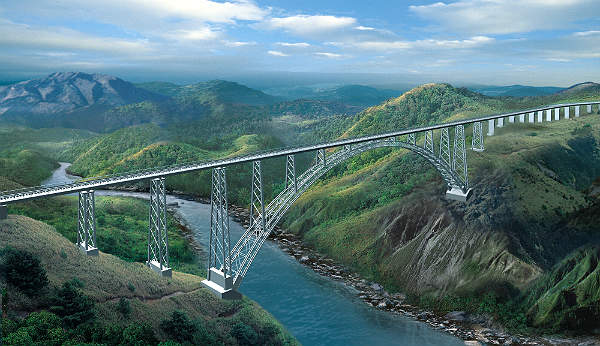
Chenab Bridge, Jammu & Kashmir India. The project was finished in 2016. Image, courtesy Konkan Railway Corporation.
By Saima Afzal 21 October 2022
India has constructed 359 meters high from the surface of the earth and a 1,315-kilometer-long Chenab Railway Bridge that connects India with the disputed territory of Kashmir. It is a concrete arch bridge constructed between Bakkal and Kauri in the Reasi district of Jammu and Kashmir. Through this bridge, Srinagar will be linked to the rest of India. It is a part of the Udhampur Srinagar Baramulla Rail Link Project (USBRL), and India claims that it is 35 meters taller than the iconic Eiffel tower in Paris. Therefore, Chenab Bridge is recognized as an engineering marvel, and various opinions exist regarding the utilization of Chenab Bridge which is expected to start operating in the coming months after the connecting rail lines are finished. The operationalization of the bridge at the same time is a cause for both optimism and pessimism among the people living in the region. Few believe that it will bring prosperity in the form of new economic markets and freedom of mobility whereas other say that railway line connectivity signals greater mainland control and unwanted transformation.
Kashmir is a disputed territory between two South Asian nuclear power India and Pakistan. Under the United Nations Security Council resolutions, Jammu and Kashmir is illegally occupied Indian territories, and India is continuously taking action to colonize the region through military means. Though India painted a rosy picture of Kashmir, her latest step is to make the Kashmir region more accessible for its illegal activities after the construction of a Chenab railway bridge. Analysts believe that Chenab Railway Bridge has been illegally constructed by India on the Chenab River to connect the disputed region of Kashmir with India’s massive rail network, making it more accessible for its military logistics and supplies.
Therefore, India’s construction of the Chenab bridge project has sparked fears and worry among the Kashmiri people who are already facing blatant human rights abuses and terror at the hands of Indian occupation forces. Kashmiris are well aware of Indian nefarious and colonial designs as Kashmir has been systematically stripped of its autonomy in recent years, and the construction of the railway signals greater Indian control and unwanted transformation of the mountainous region.
Kashmiri people and leadership have serious concerns regarding the peace and stability of the region. They firmly believe that the railway bridge connectivity will bring more instability to Kashmir which is already facing illegal Indian occupation and struggling with unjust demographic changes. Kashmiris are certain that there will be a mass population shift in the UN-declared disputed region because of this bridge which will for sure destroy the identity of the region where India has been blatantly pursuing its colonial and imperial designs.
Pakistan and India had fought over the Muslim-majority territory since 1947. Surveys have shown that many in Indian-controlled Kashmir want to merge with Pakistan or become an independent state. In recent decades, authorities have used oppressive tactics to suppress the ongoing freedom struggle of Kashmiris. The Indian security forces have been resorting to grave human rights violations, including rape and extrajudicial killings. Indian security forces have been suppressing the peaceful political freedom movement of Kashmiris. In 1990, the Kashmir freedom movement was crushed by the overwhelming and ruthless power of over 800,000 military and paramilitary forces. Indian security forces never left the region and presently Kashmir is the most militarized region under one of the most brutal regimes in the world.
India is looking to connect the disputed territory through the bridge to have a firmer grip on it with the ultimate goal of denying Kashmiris their right to self-determination guaranteed under the United Nations Security Council resolutions. Since 2019, when the Indian government unilaterally changed Kashmir’s internationally recognized disputed status and imposed a region-wide communication blackout to quell dissent, it has persistently pushed policies to cause demographic changes in severe violations of the United Nations human rights charter and international laws.
Furthermore, the Modi government has introduced electoral rights for non-locals, who are mostly non-Muslims, in Jammu and Kashmir. The move is expected to add about 2.5 million more voters on top of the 7.6 million existing voters. The people residing in Jammu for a year or more can register as voters. Eligible residents have been asked to produce government documents as proof. Those with no proof of residence will be verified at their homes. In recent years, the government has also introduced a controversial domicile law that grants citizenship rights to every Indian living in the region for more than 15 years. New laws make every Indian citizen eligible to buy land in the region.
In short, India did not abide by the UN resolutions and suppressed Kashmiris through the use of force. No state can occupy another state using force, there is a great similarity between the Kashmir issue and Israel’s illegal occupation of Palestine. India has disregarded the UN resolutions and rejected the diplomatic efforts of Pakistan to resolve the Kashmir issue peacefully. The international community must take immediate notice of Indian illegal, unilateral and provocative actions and compel it to hold a plebiscite and let Kashmiris decide their destiny according to their wishes.
*The author is an independent analyst and holds M.Phil in Peace and Conflict Studies.
